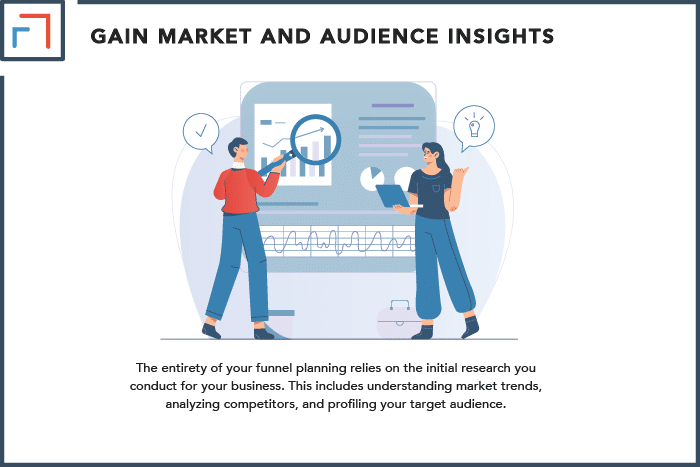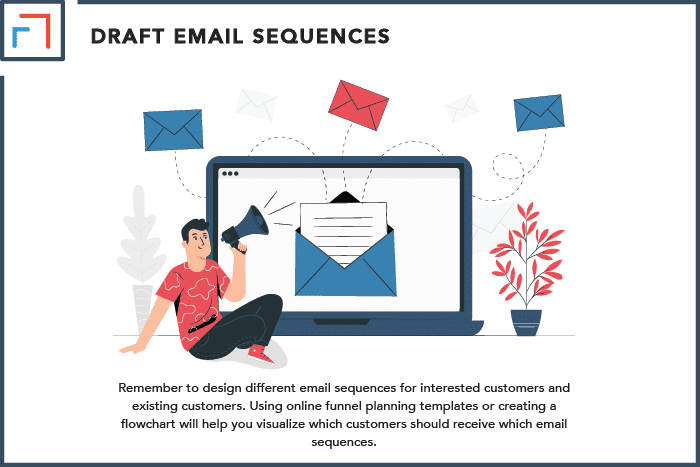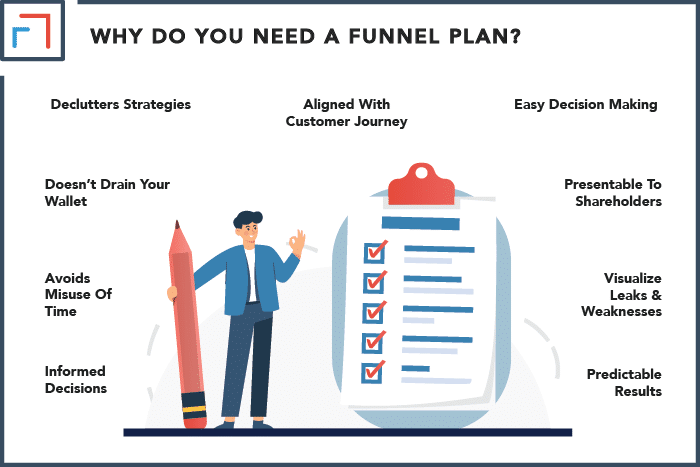An effective funnel and marketing strategy lies behind each customer’s purchase. Funnels are often used to guide potential customers toward a sale. However, a funnel is useless without a good funnel plan.
A funnel plan is a detailed step-by-step framework that’s used to set up a sales funnel. Each step in the plan is tailored to the specific position of a customer during their brand journey. The funnel plan aligns company goals with consumer insights to deliver the best results.
Funnel planning is a way to organize your brand strategy. It can help you increase your leads and retain customers (as long as you’re willing to invest a bit of time into it). Below, we’ll talk more about what a funnel plan is and how to make one.
Mapping Out Your Funnel Plan
When you’re planning your funnel strategy, you need to include the stages that support the customer journey.
In many ways, the funnel plan is an extended version of the 4 Ps of marketing (product, price, place & promotion).
Following these planning stages will ensure that your funnel works seamlessly.
1. Gain Market & Audience Insights
The entirety of your funnel planning relies on the initial research you conduct for your business.
This includes understanding market trends, analyzing competitors, and profiling your target audience.
Find out how your specific industry is developing as well as the digital market as a whole.
Your data set should include case studies, statistics, and opportunities for using innovative technology.
Similarly, consumer insights will reveal how your target audience is behaving and how your business can provide value to them.

2. Set Goals for Growth
Do you have a list of goals for your company that you want your strategies to target? How do these goals align with your brand vision and identity?
If you’re unsure, use your research data to set measurable and achievable objectives.
Define and visualize what growth means for your business while considering how it has grown in the past.
3. Choose Brand Awareness Strategies
The top of your funnel is all about creating awareness and generating traffic. The strategies you decide to use for this stage should be based on your previous research.
You could choose search engine marketing, social media ads, search engine optimization, influencer marketing, or other strategies.
Whatever you choose should align with how your target consumer behaves.
4. Develop A Niche
Your company’s value proposition depends on the niche that you have developed.
Because there is an endless sea of brands, you need to stand out by offering a service that tackles a specific consumer issue.
This part of funnel planning is linked to the “desire” stage of a funnel. Combine your consumer interests with a market opportunity of unmet needs.
5. Design High-Value Content
Whether you choose to direct your audience to blogs, podcasts, or YouTube videos, the content should provide value.
However, remember that the level of value may change depending on where a customer is in their customer journey.
For instance, you might give a brand overview for a customer at the awareness level.
But to create desire, your content should clarify how your product/service will solve the consumer’s problems.
Therefore, during your funnel planning, you should decide how to deliver targeted content at various stages.
6. Select an Opt-In Approach
You can add your audience to an email campaign or subscriber list in several different ways.
Before making a funnel, you must determine which opt-in strategy would be most effective for your specific audience.
At this point in your plan, decide whether you should use an exit pop-up, a free e-book signup page, or a valuable offer to increase your mailing list.
7. Draft Email Sequences
Remember to design different email sequences for interested customers and existing customers.
Using online funnel planning templates or creating a flowchart will help you visualize which customers should receive which email sequences.
This part of your funnel plan ensures that your email marketing is targeted and relevant to each customer and their specific place in the buyer’s journey.

8. Determine Key Performance Metrics
Funnel analytics indicate how efficiently the funnel works and where strategies need to be changed.
Determine the key performance indicators from the top to the bottom of the funnel. These metrics should not be random.
Make sure that you have strong reasoning for choosing these metrics. Understand how the numbers and data connect to your goals.
Why Do You Need A Funnel Plan?
If you want to create an effective marketing strategy, you need a funnel plan.
It’s possible to create a funnel blindly, but this approach is not as effective as going in with a plan.
Below, we’ll talk about how and why the planning process adds value to your business strategy.
1. Declutters Strategies
No matter how many funnels you choose to make, you must follow a distinct plan for each one.
This way, your marketing and sales strategies will have separate pathways and won’t get jumbled up.
2. Doesn’t Drain Your Wallet
With a funnel plan, your initial approach and tactics are pre-determined. You’ll know what you plan to spend money on and how much to set aside.
Without a plan, you can quickly go over your budget by spending funds on redundant or ineffective strategies.
3. Avoids Misuse Of Time
Since you already have everything planned out, you won’t need to spend time figuring out your next step.
Every step swiftly moves into the next one because a good plan covers every detail.
4. Aligned With Customer Journey
Every marketing strategy is directly linked to different stages within the customer journey.
By setting timed email sequences and trigger-based popups during the planning stage, your customers will receive relevant content and offers.
5. Informed Decisions
Every step of your funnel should be strategically designed and backed by data.
You are making a customized funnel that works specifically for your business and target consumers.
This would also improve your brand identity and strengthen consumer loyalty.
6. Easy Decision Making
Since the funnel plan outlines the entire process, it becomes easy to choose which strategies should be retained or removed.
Budget allocation is also simplified since every expense can be tracked within the plan. Other resources can be used efficiently and set aside when they are not needed.
7. Presentable To Shareholders
The process of designing a funnel can be difficult to explain to anyone outside the sales and marketing department.
The funnel plan breaks the entire process down into presentable chunks.
Your company’s investors, clients, or board of directors can follow the funnel plan to understand what each step aims to achieve.
8. Visualize Leaks & Weaknesses
Your funnel plan is basically a visual depiction of your entire funnel strategy.
This makes it easy to identify where leads may be getting lost. It also helps you identify the strategies that are not producing desirable results.
9. Predictable Results
Since you design every funnel step after considerable research and analysis, you can also determine expected results from the funnel.
This helps you compare projected growth with the actual results. If there are discrepancies, you can locate them and work on solutions.

Key Takeaways
Your funnel plan is the blueprint for your funnel.
Without a plan, you could end up building a dead funnel. This means you’ll waste several vital resources, including time and money.
Start your funnel planning with good research so you can understand your business and consumer needs.
Develop your plan around these findings and ensure your strategies work towards predetermined goals.
Even your funnel’s progress metrics need to be decided during the planning phase so that you have a way to measure funnel efficiency.
Although creating a funnel plan can be a long and intricate process, it ensures you save time and effort during funnel execution.
